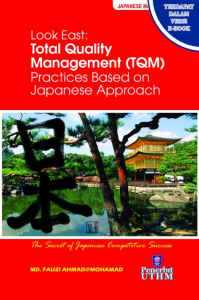LOOK EAST: TOTAL QUALITY MANAGEMENT PRACTISED BASED ON JAPANESE APPROACH
Synopsis
This book is about comparing TQM practices between the Japanese and non-Japanese companies. Analysis were made to find significant difference in TQM practices and importance between Japanese and non-Japanese companies. The results showed that there are significant differences in TQM practices. Furthermore, Japanese companies have high perception on the importance of product development. The top five quality activities implemented are: quality control circle, supplier improvement, Failure Mode Effect Analysis (FMEA), Value Engineering (VE) and quality costing. The book also proposed Quality Improvement Guidelines (QIG) framework for TQM implementation. Management leadership, TQM awareness, standardization, customer satisfaction strategies and kaizen activities are five major parts in the framework. The framework is also supported by Critical Success Factors (CSFs) to ensure the success of TQM implementation. The framework is step by step and can assist companies in meeting customer satisfaction, employee satisfaction and business growth.
Downloads
References
Ahire,S.L.,Waller,M.A., and Golhar,D.Y.(1996). Quality Management in TQM vesus non-TQM firms: An Empirical Investigation. International Journal of Quality and Reliability Management. 13(8),8-27.
Abdullah, A.R.(1993). TQM in The Public Sector Towards Continuos Improvement in Quality Management : Human Resource Development for Quality & Competitiveness in the Global Era. MAMPU, Prime Minister Department.
Ahmed, S.,Hassan,M.(2003). Survey and case investigation on application of quality management tools and technique in SMIs. International Journal of Quality and Reliability Management. 20(7),795-826.
Azizan, B.(2007). Sistem Pengurusan Kualiti.Malaysia:Prentice-Hall.
Besterfield, D.H.(2004). Quality Control.USA:Prentice-Hall.
Berry,T.H.(1991). Managing Total Quality Transformation. New York: McGraw-Hill Book Company.
Black,S.A. and Porter,L.J.(1996). Identification of the Critical Success Factors of Quality Management. Decision Sciences. 27(1),1-21.
BS7850 (1992): Part 1.Total Quality Management. Guide To Management Principle: British Standard Institution.
Cooper, Donald R. and Schindler, Pamela S. (2001). Business Research Method. New York:McGraw-Hill International Edition.
Chang, Tsung-Sang.(2002). Six Sigma: A Framework for Small and Medium-Sized Enterprises to Achieve Total Quality. Cleveland State University: Published PhD Dissertation.
Dahlgaard, J.J., Kristensen, K., Kanji, G.K., Juhl, H.J. and Sohal, A.S.(1998). Quality Management Practices:a comparative study between East and West. International Journal of Quality & Reliability Management. 15(8/9), 812-826.
Dale, B.G.(1994). Managing Quality. London: Prentice Hall.
Damanpour, S.M.P.(1988). The impact culture on management: a comparison of Japanese versus US management. Advances in competitiveness research. 6(1), 39-57.
Dyer, J.(1996). Does governance matter? Keiretsu alliances and asset specificity as source of Japanese competitive advantage. Organization Science. 7(6), 649-666.
Deming, W.E.(1986). Quality, Productivity and Competitive Position:MIT Press.
Eng, Q.E and Yusof, S.M.(2003). A survey Of TQM Practices In The Malaysian Electrical And Electronic Industry. Total Quality Management. 14(1), 63-77.
Eisenhardt, K.M.(1989). Building theories from case study research. Academy of Management Review. 14(4), 532-50.
Feigenbaum, A.V.(1986). Total Quality Control. Singapore: McGRAW-HILL.
Foster, S.T.(1991). Managing Quality. USA:Prentice-Hall.
Garvin, A.G. (1988). Managing Quality. New York : The Free Press.
Gevirtz, Charles.(1994). Developing New Products with TQM. USA: McGraw-Hill, Inc.
Hashim, Mohd Khairuddin and Wafa, Syed Azizi.(2002). Small and Medium Sized Enterprises in Malaysia. Malaysia: Prentice Hall.
Huck, Schuyler W. and Cormier, Wiliam H.(1995). Reading Statistic and Research. second edition. New York. Harper Collins Publisher Inc.
Hosotani, K.(1992). Japanese Quality Concept. New York: Quality Resource.
Idris, M.A.,McEwan W. and Belavendram N.(1996). The adoption of ISO9000 and total quality management in Malaysia. The TQM magazine. 8(5), 65-68.
Imai, M.(1997). Gemba Kaizen: a common sense, low-cost approach to management. International Edition 2001. McGraw-Hill: Singapore.
Inokuchi, S.(2006). From knowledge engineering to Kansei engineering-a study on musicperformance. 4th IEEE International Workshop. 7 Jul 1995. Tokyo.7 - 14.
Ishikawa, K.(1995). What is Total Quality Management. USA: Prentice-Hall.
ISO 8402. Part 1: Quality Vocabulary. International terms: British Standard Institution.
Juran, J.M.(1998). Juran’s Quality Handbook. Singapore: McGRAW-HILL.
Juran, J.M., Gryna,F.M.(1993). Quality Planning and Analysis. 3rd.ed. McGraw-Hill Book Company: Singapore.
Jeffrey, K.T.(2005). The Toyota way, 14 Management Principles From the World’s Greatest Manufacturer.USA: McGraw-Hill Book.
Kanji, G.K.(1990). Total Quality Management: The Second Industrial Revolution. TQM, 1(1),3-12.
Kanji G.K. & Tambi A.M.(1998). Total Quality Management and Higher Education in Malaysia. Total Quality Management. 9 (4/5), 130-132.
Khaliq, A.A.(1996). Quality Management Foundation, An Agenda for Islamization of Management Knowledge. Malaysian Management Review. Malaysian Institute of Management. 31(1), 10-20.
Kanuk and Berenson (2005).Mails Survey and Response Rate. The Journal of Marketing Research. American Marketing Association. 30(1), 450.
Kondo, Y.(1969). Internal Quality Control Audit In Japanese Companies. Quality. 10(4), 97-103.
Kuang, K.H.(2004).Quality improvement and management. Kuala Lumpur. FMM.
Lee, C.C., Lee, T.S. and Chang, C.(2001). Quality/productivity practices and Company performance in China. International Journal of Quality & Reliability Management. 8(6), 604-625.
Leonard, Denis and McAdam, Rodney.(2003). An Evaluative Framework for TQM Dynamics in Organizations. International Jounal of Operation and Production Management. 23(6), 652-677.
Li, J.H. Anderson, A.R. and Harrison, R.T.(2003). Total quality management principles and practices in China. International Journal of Quality & Reliability Management. 20(9), 1026-1050.
Mahatdir speech http://www.mofa.go.jp/region/asia-paci/malaysia/pmv0212/speech.html




